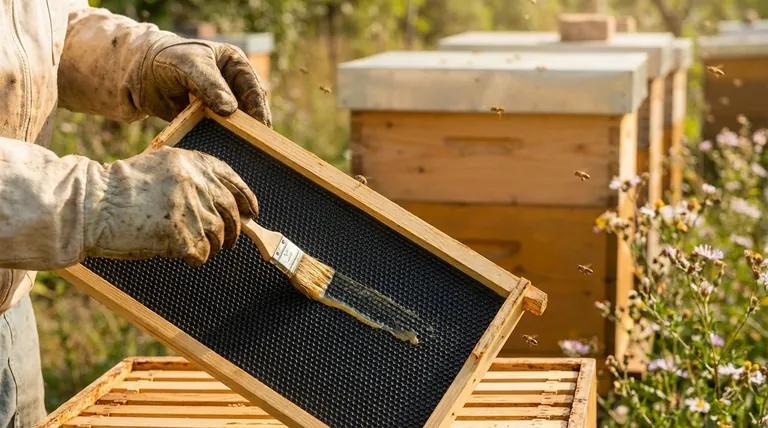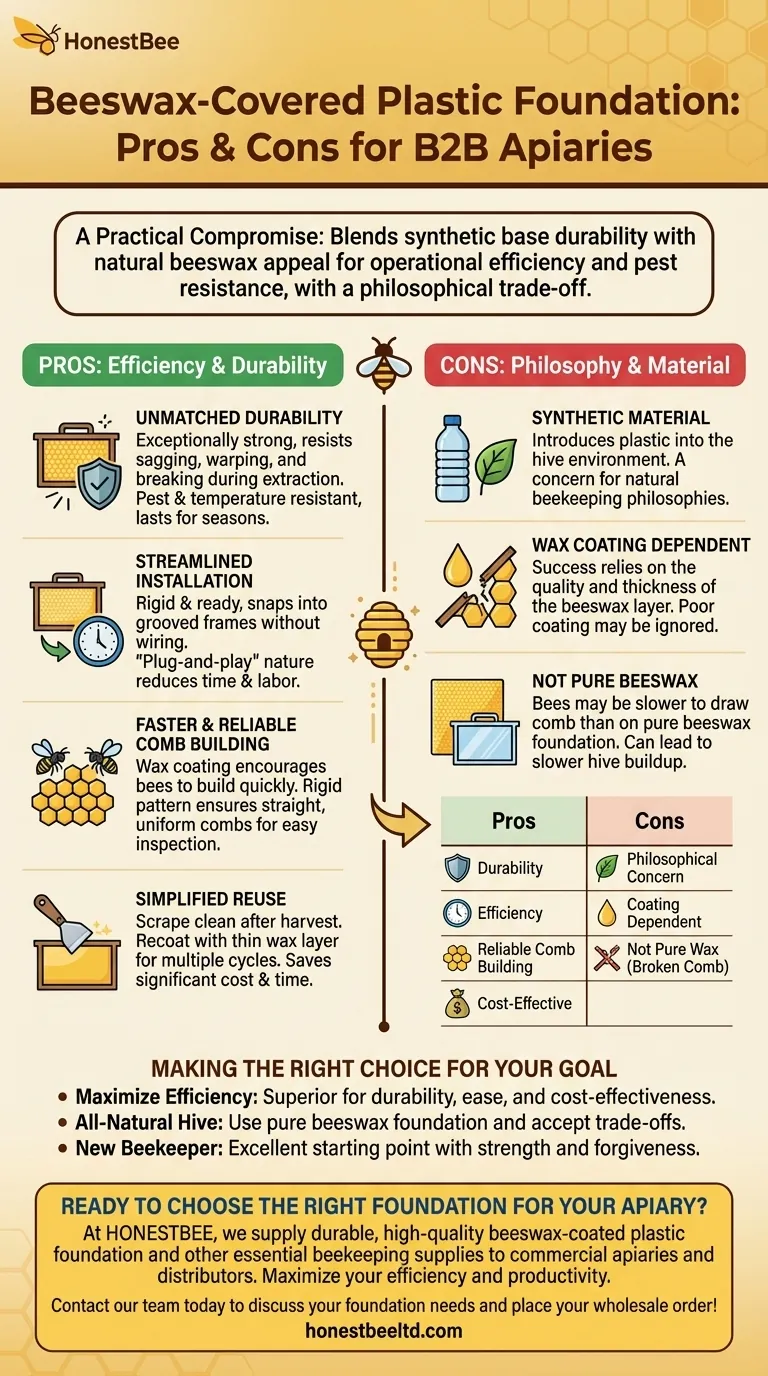In short, beeswax-covered plastic foundation is a practical compromise. It blends the durability, reusability, and rigidity of a synthetic base with the natural appeal of beeswax that encourages bees to build comb. Its primary advantages are operational efficiency and pest resistance, while the main drawback is the philosophical concern of introducing plastic into a natural hive environment.
The decision between foundation types is a fundamental choice between optimizing for operational efficiency and adhering to a more natural beekeeping philosophy. Beeswax-coated plastic is an excellent tool for saving time, money, and labor, but it comes at the cost of moving away from an all-natural hive.

Why Coated Plastic Excels in Efficiency
For many beekeepers, particularly those managing multiple hives or prioritizing ease of use, the benefits of beeswax-coated plastic foundation are undeniable. They directly address the most common points of failure and labor associated with traditional foundation.
Unmatched Durability and Longevity
Plastic foundation is exceptionally strong. It will not sag, warp, or break during honey extraction, a common issue with pure beeswax foundation.
This inherent strength means it can be stored at any temperature without degradation and is highly resistant to damage from pests like wax moths or mice. A single plastic frame can last for many seasons.
Streamlined Installation and Use
Beeswax-coated plastic foundation is rigid and ready to use out of the box. It snaps easily into grooved frames without the need for the time-consuming process of wiring, which is often required to support pure beeswax sheets.
This "plug-and-play" nature significantly reduces the time and labor needed to prepare new equipment.
Faster and More Reliable Comb Building
Bees are far more likely to accept and build upon a surface coated in familiar beeswax than on bare plastic. The wax coating provides a scent and texture that encourages them to get to work quickly.
While not always as fast as pure beeswax, the rigid pattern ensures they build straight, uniform combs, which is critical for easy hive inspections and honey extraction.
Simplified Reuse After Harvest
Perhaps the greatest efficiency gain comes after the honey harvest. Instead of replacing a damaged wax sheet, a plastic foundation can simply be scraped clean of old comb and debris.
After a quick cleaning, it can be recoated with a thin layer of melted beeswax and placed right back into service, saving significant cost and time over the life of the equipment.
Understanding the Trade-offs and Concerns
Despite its practical advantages, beeswax-coated plastic foundation is not without its drawbacks. These concerns are often centered on the material itself and its interaction with the bees.
The Introduction of a Synthetic Material
For beekeepers who prioritize a completely natural hive, the presence of plastic is a non-starter. This is the most significant philosophical argument against its use.
While the bees primarily interact with the wax coating, the foundation itself is a foreign, man-made material within their home.
The Critical Role of the Wax Coating
The success of this foundation is entirely dependent on the quality and thickness of the beeswax layer. A thin, poorly applied coating may be ignored by the bees.
Some beekeepers find they get much better results by adding an extra layer of melted beeswax themselves to factory-coated frames, which adds an extra step to the process.
It Isn't Pure Beeswax
Even with a thick coating, bees may not draw out the comb as quickly or as enthusiastically as they do on a pure beeswax foundation. The natural scent and texture of a full beeswax sheet are their ideal building material.
This can sometimes lead to slower hive buildup compared to hives using traditional foundation, especially if the nectar flow is not strong.
Making the Right Choice for Your Goal
Your decision should be guided by your specific goals, the number of hives you manage, and your personal beekeeping philosophy.
- If your primary focus is maximizing efficiency and minimizing labor: Beeswax-coated plastic is the superior choice for its durability, ease of use, and long-term cost-effectiveness.
- If your primary focus is maintaining an all-natural hive environment: You should use pure beeswax foundation and accept the associated trade-offs in durability and handling.
- If you are a new beekeeper seeking a reliable starting point: The strength and forgiveness of beeswax-coated plastic make it an excellent choice that removes several common points of frustration.
Ultimately, your choice of foundation is a defining element of your beekeeping workflow, so weigh the long-term benefits of durability against your personal principles for hive management.
Summary Table:
| Pros | Cons |
|---|---|
| Durability: Resists sagging, pests, and damage. | Philosophical Concern: Introduces plastic into the hive. |
| Efficiency: Easy installation & reusable for many seasons. | Coating Dependent: Success relies on a quality wax layer. |
| Reliable Comb Building: Encourages bees with a wax coating. | Not Pure Wax: May be slower to draw than pure beeswax. |
| Cost-Effective: Saves time and money long-term. |
Ready to choose the right foundation for your apiary?
At HONESTBEE, we supply durable, high-quality beeswax-coated plastic foundation and other essential beekeeping supplies to commercial apiaries and distributors. Our wholesale-focused operations ensure you get the reliable equipment you need to maximize efficiency and productivity.
Contact our team today to discuss your foundation needs and place your wholesale order!
Visual Guide

Related Products
- Food Grade Plastic bee Foundation for Bee Frames
- Manual Beeswax Comb Foundation Machine Wax Foundation Mill Embossing Machine
- Beeswax Foundation Sheets Beehive Foundation for Wholesale
- Electric Beeswax Foundation Machine With Operating Tray and Wax Foundation Roller
- Professional Frame Preparation: The HONESTBEE Electric Wire Embedder
People Also Ask
- How to get bees to use plastic foundation? Master the Wax Coating and Resource Strategy
- What additional step can improve the performance of plastic foundation in the hive? Apply a Generous Coat of Beeswax
- How do you get bees to draw out plastic foundation? Master the Art of Comb Building
- What factors should beekeepers consider when choosing between beeswax and plastic foundation? A Guide to Durability vs. Natural Philosophy
- What is a plastic foundation sheet? A Durable, Reusable Hive Management Solution



















